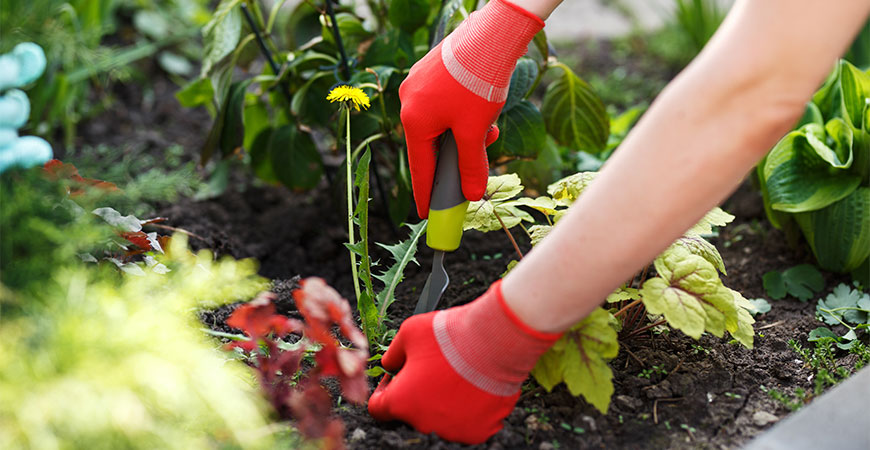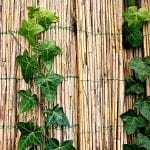
Common Weeds & How to Eliminate Them
Weeds are an unwelcome guest for any homeowner. And common weeds can disrupt the beauty of a well-maintained garden or lawn. And when there is one weed, new ones are sure to follow.
Weeds in the yard compete for the sunlight and nutrients necessary for a healthy, green lawn. Here we’ll cover the most common weeds you may see in your garden and lawn and offer weed removal and prevention tips.
What are the most common types of weeds?
One of the first steps in weed control is to identify what types of weeds are growing in your garden or lawn. Once you know this, you can plan the method of removal. Each garden weed can fall into several categories –
Grass-like Weeds:

These thin-bladed plants grow in the same conditions as your lawn, which is why they are commonly seen in most turf grasses. Examples of a grass-like weed include goosegrass, crabgrass, orchard grass, and foxtail.
Broadleaf Weeds:

As the name suggests, broadleaf weeds have wider leaves and often flower. Broadleaf plants include dandelions, clover, chickweed, henbit, thistle, and wild violets. Broadleaf plants are usually easier to treat compared to their grass-like cousins.
Garden and lawn weeds can also be identified by their growing cycle. Perennial plants come back year-to-year, while annual plants live just one season.
Annual Weeds:
Types of annual plants include bluegrass, crabgrass, and foxtail. Although annuals have a one-year growing cycle, they can sprout several times during warmer months.
Use a pre-emergent in late fall to prevent annual plants from popping up next spring and to prevent annual weed seeds from germinating in the fall.
Perennial Weeds:
Persistent perennials plants return every year if not treated or removed. Types of perennial weeds include plantain, quackgrass, bindweed, thistle, dandelions, and nutsedge.
Crabgrass, spurge, and nutsedge are considered warm-season perennial plants as they thrive in warm temperatures. Dandelions, chickweed, and clover are considered cool-season perennials as they grow more readily in spring and fall.
When are weeds most likely to appear?
Grass-like weed seeds fall to the ground in fall and germinate in spring. Each annual broadleaf plant germinates in the fall, and the seeds that survive the winter, flower in spring.
Each perennial plant has underground root structures that stay overwinter in the soil to sprout again when warm weather arrives.
Weed seeds are usually small and light, easily floating in the breeze. They travel across the garden on the wind to eventually land and take root in the soil.
One of the best ways to prevent new plants is to remove them from your garden or yard before they go to seed. Some common weed species can produce thousands of seeds from just one plant!
Do weeds prefer a specific type of soil?
Weeds differ widely in preferences for soil type and conditions. Interestingly, these creeping plants can inform you of your soil’s condition– current drainage, nutrients, and pH level.
- Moss can indicate poor drainage, compacted soil, or low fertility.
- Red sorrel, docks, lady’s thumb, and horsetail indicate a low pH level.
- Burdock and chickweed can be found in rich, naturally moist soil.
- Hawkweed prefers acidic soil.
- And some are opportunistic, quickly sprouting in any newly tilled soil.
What’s the best way to remove garden weeds?
Below are five organic ways to rid your lawn or garden of the most common weeds.
Hand Weeding
Old-fashioned hand weeding or pulling is one of the best methods to remove common weeds. It’s one of the best ways to remove dandelion, sedge, wood sorrel, and Bermuda grass. Pull them when they are small and tender and before they have a chance to spread and produce seeds.
Dandelions have a thick taproot, so a fishtail weeding tool or a dandelion fork will assist you in digging them up, root and all. When pulling each perennial plant, remove the entire plant, including the roots, tubers, and rhizomes. Any pieces left behind can quickly sprout.
Mulching

Mulch is a proven organic method of suppressing weed growth. Apply a layer of mulch early in the growing season, before annual plants germinate. Be sure to remove existing weeds, as adding a layer of mulch over them won’t stop their growth.
Those little invaders will pop up through the covering. Mulches made of commercial leaf compost or shredded hardwood bark are good choices.
If you prefer lightweight mulch, use straw, not hay. Why? Hay often contains weed seeds, while straw is made up of the dried stems of grains and is usually weed-free.
Don’t overdo – too much mulch may minimize soil aeration. Thick mulch also creates the perfect breeding ground for white mildew. It’s best to apply a layer of mulch 2 to 3 inches deep.
Newspaper Barrier
For extra weedy spots, use sheets of newspaper as a barrier from your common everyday weed. If a thick layer of mulch isn’t doing the trick, place wet newsprint on the ground before spreading mulch on top. Cover the plant bed with sheets of wet newspaper, several sheets thick. Use the black and white sections as the ink color inserts may contain metals.
Weeding with Fire

If you enjoy garden gadgets, you may enjoy flame weeding. A flame weeder is designed to cause plant heat shock, damaging plant cells. Flame weeders work well to spot kill common weeds that have set up shop in driveway cracks along fence lines.
Flame weeders are sold in hand-held or backpack styles. The flame is usually adjustable to a narrow range so that it can be used in tight spaces such as vegetable rows. After exposure to the propane flame, they will have a glassy look and begin to wilt in a few hours.
Tarping
Consider tarping for a tough perennial weed like Canadian thistle, bindweed, or Japanese knotweed. This smothering technique also works well for large clumps of weeds.
Start by cutting them close to the ground. Then spread a black or dark-color tarp over the area. Pin down the tarp edges with garden staples or a thick soil layer.
Leave the tarp in place. The sun’s heat will build up under the tarp to smother and kill each weed.
Bonus Tip: Keep your gardening tools (hoe, spade, shovel, tiller) clean to prevent the spread of weed seeds to another garden area.










